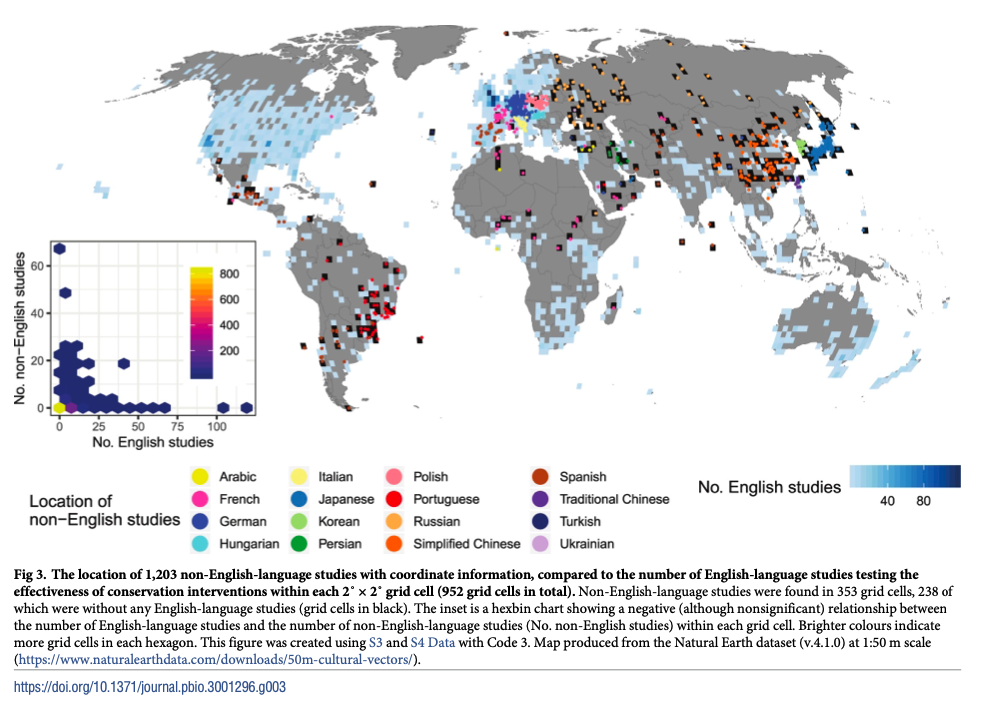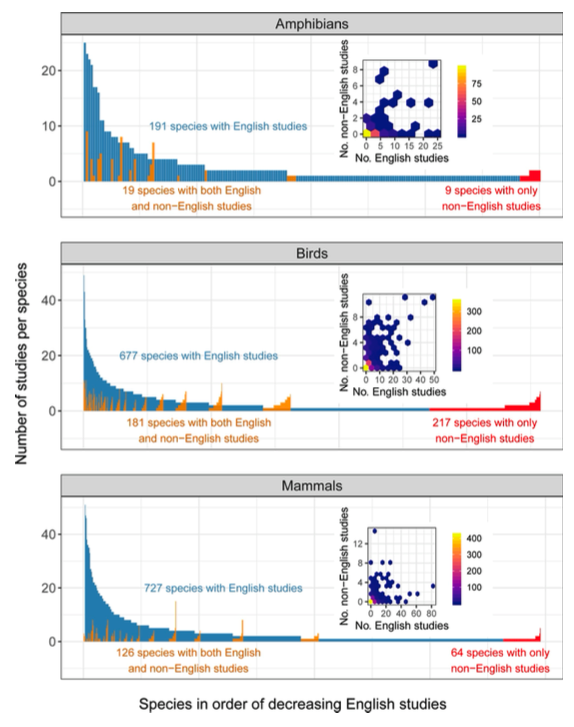How Translation Will Enrich International Biological Research (and Hopefully, Save the World)
In early 2020—when COVID-19 was slowly making its way across the globe—Nintendo released Animal Crossing: New Horizons, a social simulation game that kept more than 37 million people around the world company. Ported specifically for the Nintendo Switch console, the game allows users to build and decorate their own island, befriend cute, quirky animal neighbors, expand their houses by taking out loans, and catch and collect local flora and fauna.
The lattermost activity—completing a collection of fish, insects, flowers, fossils, and subaquatic creatures—is one of the most exciting quests in the game; users donate their findings to an owl NPC in an enormous museum, which they can visit at any time to enjoy and learn more about their discoveries. For people who’ve grown up in the city and didn’t know much about wildlife, Animal Crossing: New Horizons was a testament to how exciting—and diverse—the natural world can be. Localized into the major Romance languages alongside Dutch, Russian, and the three major East Asian languages, the game has cultivated a following of avid international users who, despite their linguistic differences, are united by the version of nature they encounter in this simulation game.
Animal Crossing: New Horizons is also proof that every culture has a different relationship to nature, evidenced by the widely different names languages use to call the same species of fish or insect. The small, colorful fish known as bitterling in English (fishable in the game’s many rivers) is known as amarguillo in Spanish; in Japan, it’s known as tanago, and in Russia, it takes the name gorchak. For players who speak one of these 16 languages the game has been localized in, the game allows them to reconnect with nature—divorced from them due to the long-lasting pandemic—in their own language.
The reality
However, in the academic discourse of biology, the natural world isn’t as vibrant or diverse as the various names we call our wildlife. In a landmark research published in 2021 by more than 60 biological researchers around the world titled Tapping into non-English-language science for the conservation of global biodiversity, it is revealed that “to date, non-English-language studies have largely been ignored in evidence synthesis,” and that “the underuse of non-English-language science” is prevalent across disciplines.
Academia has unknowingly adopted English as its primary—and most times, the sole—language of knowledge dissemination, rendering scientific works in other languages largely ignored. If we were to explain this in terms of Animal Crossing: New Horizons, any kind of research or documentation done about the bitterling in another language—any papers about amarguillo or tanago or gorchak—would be cast aside. The only research that matters are the ones about the bitterling, written in English (although the fish itself would be called by its genus, Rhodeus, perhaps).
This is a problem, because “non-English-language studies provide crucial evidence for informing global biodiversity conservation.” Of the 419,679 peer-reviewed papers screened by the researchers, there were 1,234 non-English-language studies that provide evidence on the effectiveness of biodiversity conservation interventions, as compared to 4,412 English-language studies within the same criteria. The researchers posit that “incorporating non-English-language studies can expand the geographical coverage… of English-language evidence by 12% to 25%… and taxonomic coverage by 5% to 32%.” There is so much biodiversity being left out because non-English-language research is ignored in the English-dominated discourse of biology.
The researchers note how history is proof of the necessity of international, linguistically diverse research. For example, primary research into developing the Nobel Prize-winning antimalarial drug was first published in Mandarin.Eduardo H. Rapoport’s influential study of biodiversity, Areografía: estrategias geográficas de las especies, was published in Spanish. Even now, “many of the earliest papers on COVID-19 were written, again, in simplified Chinese.” But still, such non-English-language contributions to science and scientific communities—and hence, the broader society—are seldom quantified.
Research
To examine the broader picture of linguistic variety in academia, the researchers carried out an intense “assessment of non-English-language studies’ contribution to evidence synthesis—the process of compiling an summarising scientific information from a range of sources.” More specifically, the researchers screened 419,679 peer-reviewed papers in 326 journals, published in 16 languages, and identified non-English studies “testing the effectiveness of interventions in biodiversity conservation.”
The sixteen languages chosen were the top 15 non-English languages, ranked by their number of conservation-related publications. The list excludes Swedish and Dutch (as the researchers could not find any native speakers of these languages to collaborate with) and covers three additional languages (Arabic, Hungarian, and Ukrainian.) 38 total native speakers of the 16 languages were recruited, taking into account their education and area of study to make sure that they were capable of understanding the content of the studies covered. The searchers were then trained for a wide range of academic abilities necessary for the research.
The 326 journals were chosen by native speakers who were also academics in the field, rating each journal by its relevancy. Of most relevancy were journals in ecology, biodiversity conservation, and taxonomic studies, such as “ornithology, mammalogy, herpetology, plant sciences, etc.” Less relevant were journals in other related disciplines, such as “agricultural/forest sciences and general zoology.” The researchers aimed to include most of the journals that fell in the “most relevant” category and tried to include journals in the just “relevant” category as much as possible.
In the final step of the research, searchers scanned the “title and abstract of every peer-reviewed non-English-language paper published in the journal and by reading the main text of all papers” that met the eligibility criteria for the research. Their findings were then tested to see if they met the two major criteria they had for their contribution to biodiversity studies, documented for various categories of metadata, then compared for important information such as study designs, study locations, yearly changes, proportions of eligible studies by journal, and the species covered.
Results
The research revealed that non-English-language studies “expanded the geographical coverage based on English-language studies” for amphibians by 12%, birds by 16%, and mammals by 12%. The 1,234 non-English-language studies together made up a total of “1,954 unique species recognised by the International Union for Conservation of Nature (IUCN),” including 40 amphibians (6 threatened), 564 birds (37 threatened), and 194 mammals (22 threatened). As for species not covered by English-language studies, the non-English-language studies provided scientific evidence for an additional 9 amphibians, 217 birds, and 64 mammals. Non-English-language studies also “increased the evidence coverage of threatened species by 23% for birds and 3% for mammals. “
Regarding the quality of the studies, the research found that “the proportion of eligible studies in each journal varied among languages.” Japanese had the highest proportion of eligible studies in a journal with 26.7%, followed by Hungarian with 15.3%, then French (12.9%), then German (9.1%).
The number of eligible non-English-language studies increased significantly over the years since 2000 in 6 of the languages studied, with Portuguese and Russian showing a notable increase and traditional Chinese showing a “marginally significant increase.” This finding refutes the popular perception that “the number of non-English-language studies providing evidence is declining.” If anything, the number of relevant studies in languages other than English is growing, if slowly overall.
However, the results of the study do support the popular perception that “non-English-language studies tend to be based on less robust study designs.” More specifically, studies in 10 of the 16 languages covered were more likely to adopt less robust study designs compared to studies done in English. As such, there is also a correlation with the quality of the studies, which suffers when the study designs are less robust.
Conclusion
In all, this research goes to prove that “synthesising non-English-language studies could be an effective avenue for reducing the exisiting, severe gaps in the geographical and taxonomic coverage of available scientific evidence for biodiversity conservation.” There is a divide between English and non-English studies, and taking the latter into account in the international discourse on biodiversity is very “critical to halting the ongoing biodiversity crisis.”
After all, the natural world doesn’t distinguish or discriminate based on language or culture. In an interconnected society like this, the demise of one natural habitat is detrimental to another—even if it’s miles and miles away. However, current gaps in evidence hinder conservation-related decision-making on a global level. The researchers proffer three ways in which non-English-language studies could be particularly important:
Over one-third of scientific documents on biodiversity conservation are published in languages other than English.
Gaps in globally compiled English-language evidence are often found in areas where English is not widely spoken.
Important evidence in biodiversity conservation is routinely generated by local practitioners, who often prefer publishing their work in their first language, which, for many, is not English.
Based on the research done, non-English-language studies were shown to largely disprove common misconceptions, instead proving the following:
A considerable amount of scientific evidence underpinning effective conservation is available in non-English languages.
The number of published studies providing such evidence has been increasing in many languages.
Non-English-language studies can provide evidence that is relevant to species (including threatened species) and locations (including highly biodiverse regions, such as Latin America) for which little or no English-language evidence is available.
As noted before, non-English-language studies tend to utilize less robust study designs and thus be of lesser quality than their English-language counterparts. It is important to note, as the researchers state, that “blindly discarding such lower-quality, yet relevant, studies—a common practice in conventional evidence syntheses—could unnecessarily delay, misinform, or hinder evidence-based decision-making, especially… for emergent issues, such as pandemics, where making the best use of available evidence is an urgent challenge.”
But the solution offered by this research isn’t meant to be perfect. Incorporating more non-English-language studies can help diversify and enrich—and hence drastically improve—international studies into biodiversity and conservation, but even this account of studies carried out in the world’s top 16 language isn’t enough to cover everything. The researchers confess that this study does not “fully address the large evidence gaps in some regions faced with the most pressing issues including biodiversity loss, such as Southeast Asia, tropical Africa, and Latin America.”
What are some feasible solutions, then, that can be taken to address these inherent issues in the academic foray into biodiversity? More local evidence—any kind, as long as they’re based on robust study designs—is imperative, and should be encouraged in any local language. This method should also be complemented by “the distribution of free teaching materials to facilitate the testing of conservation interventions.”
What does this mean for translators?
With an increase in global communication in academia comes a greater need for translation services that properly ensure that no part of the research is lost. There will be a rise in demand for translators equipped with the proper experiences and knowledge to accurately translate academic, scientific texts. While we are not yet sure how far the impact of this research will travel, it’s nice—at times like these—to know that translators aren’t just sitting idly by, typing away at their computers. They play an integral role in protecting the world’s ecosystems.
When we think about it, translators are often deemed to be vehicles of communication; they are never the creators of meaning, but rather, messengers that ensure a message is properly received. But without this crucial link between languages, there is so much that can be lost in translation. This is true not only for biodiversity, but also for healthcare, business, and practically every other major field of study and industry.
We envision a world that, funny as it sounds, is akin to Animal Crossing: New Horizons, in which languages no longer serve as barriers, but rather multiply and enrich our lived experiences—whether that be with our quirky neighbors or our local flora and fauna. And this research—available here on PLOS—is just another proof that translators are here to stay.

